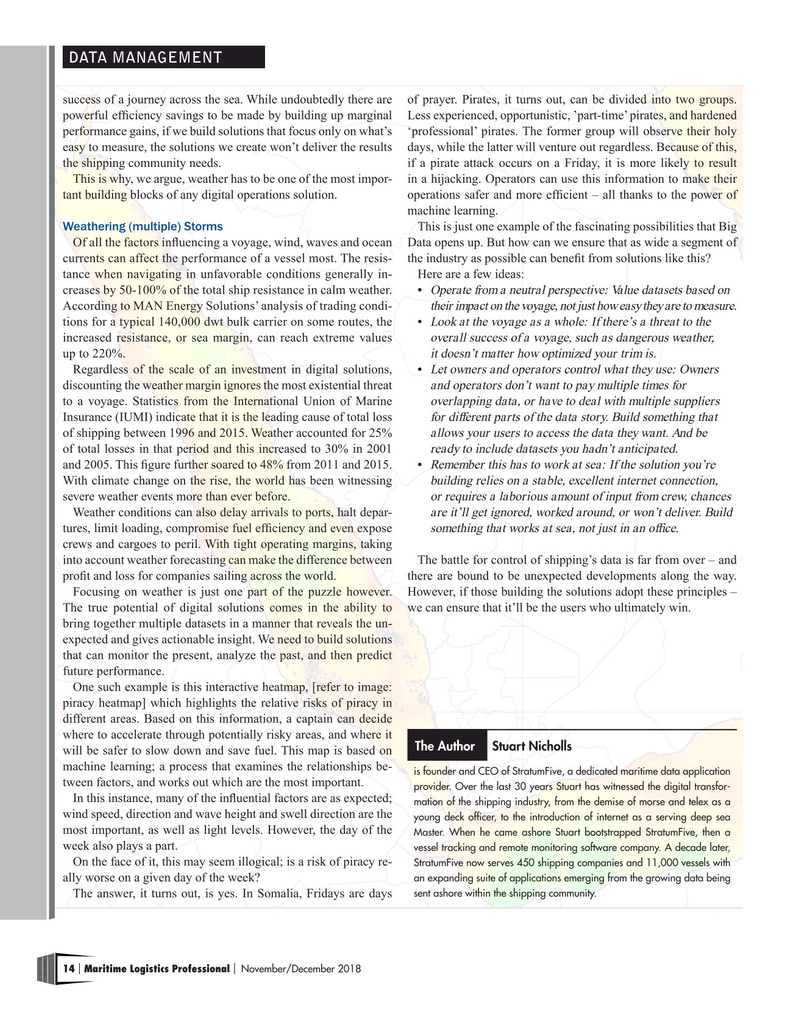
Page 14: of Maritime Logistics Professional Magazine (Nov/Dec 2018)
Regulatory & Environmental Review
Read this page in Pdf, Flash or Html5 edition of Nov/Dec 2018 Maritime Logistics Professional Magazine
DATA MANAGEMENT success of a journey across the sea. While undoubtedly there are of prayer. Pirates, it turns out, can be divided into two groups. powerful effciency savings to be made by building up marginal Less experienced, opportunistic, ’part-time’ pirates, and hardened performance gains, if we build solutions that focus only on what’s ‘professional’ pirates. The former group will observe their holy easy to measure, the solutions we create won’t deliver the results days, while the latter will venture out regardless. Because of this, the shipping community needs. if a pirate attack occurs on a Friday, it is more likely to result
This is why, we argue, weather has to be one of the most impor- in a hijacking. Operators can use this information to make their tant building blocks of any digital operations solution. operations safer and more effcient – all thanks to the power of machine learning.
Weathering (multiple) Storms This is just one example of the fascinating possibilities that Big
Of all the factors infuencing a voyage, wind, waves and ocean Data opens up. But how can we ensure that as wide a segment of currents can affect the performance of a vessel most. The resis- the industry as possible can beneft from solutions like this?
tance when navigating in unfavorable conditions generally in- Here are a few ideas: creases by 50-100% of the total ship resistance in calm weather. • Operate from a neutral perspective: Value datasets based on
According to MAN Energy Solutions’ analysis of trading condi- their impact on the voyage, not just how easy they are to measure.
tions for a typical 140,000 dwt bulk carrier on some routes, the • Look at the voyage as a whole: If there’s a threat to the increased resistance, or sea margin, can reach extreme values o verall success of a voyage, such as dangerous weather, up to 220%. it doesn’t matter how optimized your trim is.
Regardless of the scale of an investment in digital solutions, • Let owners and operators control what they use: Owners discounting the weather margin ignores the most existential threat and operators don’t want to pay multiple times for to a voyage. Statistics from the International Union of Marine o verlapping data, or have to deal with multiple suppliers
Insurance (IUMI) indicate that it is the leading cause of total loss for dif ferent parts of the data story. Build something that of shipping between 1996 and 2015. Weather accounted for 25% allows your users to access the data they want. And be of total losses in that period and this increased to 30% in 2001 r eady to include datasets you hadn’t anticipated.
and 2005. This fgure further soared to 48% from 2011 and 2015. • Remember this has to work at sea: If the solution you’re
With climate change on the rise, the world has been witnessing b uilding relies on a stable, excellent internet connection, severe weather events more than ever before. or r equires a laborious amount of input from crew, chances
Weather conditions can also delay arrivals to ports, halt depar- ar e it’ll get ignored, worked around, or won’t deliver. Build tures, limit loading, compromise fuel effciency and even expose something that works at sea, not just in an offce.
crews and cargoes to peril. With tight operating margins, taking into account weather forecasting can make the difference between The battle for control of shipping’s data is far from over – and proft and loss for companies sailing across the world. there are bound to be unexpected developments along the way.
Focusing on weather is just one part of the puzzle however. However, if those building the solutions adopt these principles –
The true potential of digital solutions comes in the ability to we can ensure that it’ll be the users who ultimately win.
bring together multiple datasets in a manner that reveals the un- expected and gives actionable insight. We need to build solutions that can monitor the present, analyze the past, and then predict future performance.
One such example is this interactive heatmap, [refer to image: piracy heatmap] which highlights the relative risks of piracy in different areas. Based on this information, a captain can decide where to accelerate through potentially risky areas, and where it
The Author Stuart Nicholls will be safer to slow down and save fuel. This map is based on machine learning; a process that examines the relationships be- is founder and CEO of StratumFive, a dedicated maritime data application tween factors, and works out which are the most important.
provider. Over the last 30 years Stuart has witnessed the digital transfor-
In this instance, many of the infuential factors are as expected; mation of the shipping industry, from the demise of morse and telex as a wind speed, direction and wave height and swell direction are the young deck offcer, to the introduction of internet as a serving deep sea most important, as well as light levels. However, the day of the
Master. When he came ashore Stuart bootstrapped StratumFive, then a week also plays a part.
vessel tracking and remote monitoring software company. A decade later,
On the face of it, this may seem illogical; is a risk of piracy re-
StratumFive now serves 450 shipping companies and 11,000 vessels with an expanding suite of applications emerging from the growing data being ally worse on a given day of the week?
sent ashore within the shipping community.
The answer, it turns out, is yes. In Somalia, Fridays are days 14 Maritime Logistics Professional November/December 2018 | |

 13
13

 15
15
